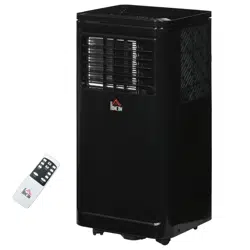Loading ...
Loading ...
Loading ...

4
● NOTE: Switching off the appliance via the power button does NOT disconnect the
appliance from the power supply.
● Do not install or use the air conditioner in any area where the atmosphere contains
combustible gases or where the atmosphere is contaminated. Avoid any chemicals
coming in to contact with your air conditioner.
● Do not store anything directly on top of the air conditioner.
● Under guided supervision, this appliance can be used by children aged eight years and
above, provided they understand the potential risks and hazards. Under guided
supervision, this appliance can be used by persons with disabilities or persons without
experience, provided they understand the potential risks and hazards.
● This appliance is not intended for people (including children) with reduced physical,
sensory or mental capabilities, or lack of experience and knowledge, unless they have
been given supervision or instruction concerning use of the appliance by a person
responsible for their safety. Children should be supervised to ensure that they do not
play with the appliance.
● Use two or more people to move and install this air conditioner.
● Never operate the air conditioner without the filters in place.
● Do not use the air conditioner near a bathtub, shower, wash basin or other wet area.
● Do not use means to accelerate the defrosting process or to clean, unless
recommended by the manufacturer.
● Keep the appliance away from ignition sources, such as open flames, an operating gas
appliance or electric heater. Do not pierce or burn.
● Be aware that refrigerants may not contain an odour. -The maximum refrigerant charge
amount: NPLA1-05C/X1E-6.7Oz, NPLA1-06C/X1E-8.3Oz.
● Store the appliance in a place where mechanical damage is prevented.
● Any person who is involved with working on or breaking into a refrigerant circuit, should
hold a current valid certificate from an industry-accredited assessment authority, which
authorises their competence to handle refrigerants safely in accordance with an
industry recognised assessment specification. Servicing shall only be performed as
recommended by the manufacturer. Maintenance and repair, requiring the assistance
of other skilled personnel, shall be carried out under the supervision of the person
competent in the use of flammable refrigerants.
● Prior to beginning work on systems containing flammable refrigerants, safety checks
are necessary to ensure the risk of ignition is minimal. Work shall be undertaken under
a controlled procedure to minimise the risk of a flammable gas or vapour being present
while the work is being performed. All maintenance staff and others working in the local
area shall be instructed on the nature of work being carried out. Avoid working in
confined spaces. The area around the workspace shall be sectioned off. Ensure the
area is safe by controlling flammable material.
● Check the area with an appropriate refrigerant detector before and during work, so you
can be made aware of potential flammable atmospheres. Ensure the leak detection
equipment being used is suitable for use with flammable refrigerants (no sparking,
adequately sealed and properly safe).
● If hot work is conducted on the refrigeration equipment or associated parts, fire
extinguishing equipment must be nearby. Have a dry power or CO² fire extinguisher
next to the charging area.
● If working on the refrigeration system requires exposing pipes that contain flammable
refrigerants, you must not use sources of ignition – this is a fire or explosion hazard.
Keep all ignition sources, including cigarettes, far away from the site of installation,
repairing and disposal – flammable refrigerants could be released into the surrounding
area.
● Before work taking place, check the surrounding area, ensuring there are no flammable
hazards or ignition risks. 'No Smoking' signs must be displayed.
● Before breaking into the system or conducting any hot work, the area must be open or
well ventilated, so any released refrigerants can be safely released into the
atmosphere.
Loading ...
Loading ...
Loading ...
